Employing Bibliometric Analysis to Identify the Current State of the Art and Future Prospects of Electric Vehicles
Abstract
1. Introduction
1.1. Background
1.2. EVs’ Role in Urban/Sustainable Transportation
1.3. Taxonomy of EVs
- Battery Electric Vehicles (BEVs): BEVs are vehicles that run solely on electricity stored in rechargeable batteries. They are powered by an electric motor, which drives the wheels, and do not have any internal combustion engines. Instead of gasoline, they rely on energy stored in batteries, which can be recharged from an external power source. A typical BEV ranges from 160 to 250 km, though some can travel up to 500 km on a single charge. The Nissan Leaf is an example of this type of vehicle. It is 100% electric and currently has a 62 kWh battery that allows users to travel 360 km on a single charge.
- Plug-In Hybrid Electric Vehicles (PHEVs): PHEVs are vehicles that combine a conventional internal combustion engine with an electric motor and a rechargeable battery. They can be powered by either the internal combustion engine or the electric motor, or a combination of both. The Mitsubishi Outlander PHEV has a 12 kWh battery, allowing it to travel 50 km solely on electricity. However, it is worth noting that PHEVs’ fuel consumption is higher than manufacturers’ estimates.
- Hybrid Electric Vehicles (HEVs): (HEVs) are vehicles that use both a conventional internal combustion engine and an electric motor to power the vehicle. The electric motor assists the internal combustion engine, providing extra power when needed, such as during acceleration, and captures energy normally lost during braking to recharge the battery. The internal combustion engine and electric motor work together to power the vehicle, with the electric motor providing additional power when needed and the internal combustion engine providing range and power for longer trips. The Toyota Prius (4th generation) hybrid model includes a 1.3 kWh battery, which theoretically enabled it to travel up to 25 km in all-electric mode.
- Fuel-cell Electric Vehicles (FCEVs): FCEVs are vehicles that use a fuel cell to generate electricity to power an electric motor. The fuel cell generates electricity through a chemical reaction between hydrogen and oxygen, producing only water as a byproduct. FCEVs have a similar driving experience to battery electric vehicles, with instant torque and quiet operation, but have a much longer driving range between refuelings. The Hyundai Nexo FCEV can travel 650 km without refueling.
- Extended-range EVs (EREVs): (EREVs) are vehicles that have a small internal combustion engine that is used to recharge the battery, extending the driving range of the vehicle. The vehicle operates primarily on electricity stored in the battery, with the internal combustion engine kicking in when the battery is depleted to extend the driving range. The BMW i3 is an example of this type of vehicle, with a 42.2 kWh battery that provides 260 km of autonomy in electric mode and an additional 130 km in extended-range mode.
1.4. Significance, Objectives, and Structure of the Study
- (1)
- What are the article distribution trends in EV research from 2011 and 2022?
- (2)
- What contributions have eminent researchers, leading countries, and the most-active academic institutions made?
- (3)
- What are the most common keywords, research fields, and top journals?
- (4)
- Which nation is dominant in terms of large applications, sales, and market of EVs?
2. Methods and Data Collection
2.1. Bibliometric Overview Method
2.2. Publication Count
3. Results and Discussion
3.1. Countries Active in Research on EVs
3.2. Leading Organizations Scientific Analysis
3.3. Co-Authorship Scientific Mapping
3.4. Bibliographic Coupling Network Analysis
3.5. Scientific Mapping of Journals
3.6. Keyword Co-Occurrence Scientific Mapping
4. Conclusions and Future Perspectives
Author Contributions
Funding
Data Availability Statement
Acknowledgments
Conflicts of Interest
References
- Walters, J.G.; Marsh, S.; Rodrigues, L. A Rural Transport Implementation Index for Connected, Autonomous and Electric Vehicles. Future Transp. 2022, 2, 753–773. [Google Scholar] [CrossRef]
- Graham, J.D.; Brungard, E. Consumer Adoption of Plug-In Electric Vehicles in Selected Countries. Future Transp. 2021, 1, 303–325. [Google Scholar] [CrossRef]
- Hussain, I.; Wang, H.; Safdar, M.; Ho, Q.B.; Wemegah, T.D.; Noor, S. Estimation of Shipping Emissions in Developing Country: A Case Study of Mohammad Bin Qasim Port, Pakistan. Int. J. Environ. Res. Public Health 2022, 19, 11868. [Google Scholar] [CrossRef] [PubMed]
- Ullah, I.; Liu, K.; Yamamoto, T.; Zahid, M.; Jamal, A. Electric Vehicle Energy Consumption Prediction Using Stacked Generalization: An Ensemble Learning Approach. Int. J. Green Energy 2021, 18, 896–909. [Google Scholar] [CrossRef]
- Ullah, I.; Liu, K.; Yamamoto, T.; Al Mamlook, R.E.; Jamal, A. A Comparative Performance of Machine Learning Algorithm to Predict Electric Vehicles Energy Consumption: A Path towards Sustainability. Energy Environ. 2021, 33, 1583–1612. [Google Scholar] [CrossRef]
- Bhardwaj, S.; Mostofi, H. Technical and Business Aspects of Battery Electric Trucks—A Systematic Review. Future Transp. 2022, 2, 382–401. [Google Scholar] [CrossRef]
- Makeen, P.; Ghali, H.A.; Memon, S. A Review of Various Fast Charging Power and Thermal Protocols for Electric Vehicles Represented by Lithium-Ion Battery Systems. Future Transp. 2022, 2, 281–299. [Google Scholar] [CrossRef]
- Gezmish, M.; Truong, L.T. Estimating the Potential of Electric Vehicles for Travelling to Work and Education in Melbourne, Victoria. Future Transp. 2021, 1, 737–746. [Google Scholar] [CrossRef]
- Wang, Z.; Safdar, M.; Zhong, S.; Liu, J.; Xiao, F. Public Preferences of Shared Autonomous Vehicles in Developing Countries: A Cross-National Study of Pakistan and China. J. Adv. Transp. 2021, 2021, 5141798. [Google Scholar] [CrossRef]
- Safdar, M.; Jamal, A.; Al-Ahmadi, H.M.; Rahman, M.T.; Almoshaogeh, M. Analysis of the Influential Factors towards Adoption of Car-Sharing: A Case Study of a Megacity in a Developing Country. Sustainability 2022, 14, 2778. [Google Scholar] [CrossRef]
- Ullah, I.; Liu, K.; Vanduy, T. Examining Travelers’ Acceptance towards Car Sharing Systems—Peshawar City, Pakistan. Sustainability 2019, 11, 808. [Google Scholar] [CrossRef]
- Ullah, I.; Jamal, A.; Subhan, F. Public Perception of Autonomous Car: A Case Study for Pakistan. Adv. Transp. Stud. 2019, 49, 145–154. [Google Scholar]
- Brady, J.; O’Mahony, M. Travel to Work in Dublin. The Potential Impacts of Electric Vehicles on Climate Change and Urban Air Quality. Transp. Res. Part D Transp. Environ. 2011, 16, 188–193. [Google Scholar] [CrossRef]
- Ogunkunbi, G.A.; Al-Zibaree, H.K.Y.; Meszaros, F. Evidence-Based Market Overview of Incentives and Disincentives in Electric Mobility as a Key to the Sustainable Future. Future Transp. 2021, 1, 290–302. [Google Scholar] [CrossRef]
- Olivier, J.G.; Schure, K.M.; Peters, J. Trends in Global CO2 and to Tal Greenhouse Gas Emissions. Summary of the 2017 Report; PBL Report; PBL Netherlands Environmental Assessment Agency: The Hague, The Netherlands, 2017. [Google Scholar]
- Liu, K.; Wang, J.; Yamamoto, T.; Morikawa, T. Exploring the Interactive Effects of Ambient Temperature and Vehicle Auxiliary Loads on Electric Vehicle Energy Consumption. Appl. Energy 2018, 227, 324–331. [Google Scholar] [CrossRef]
- Liu, K.; Wang, J.; Yamamoto, T.; Morikawa, T. Modelling the Multilevel Structure and Mixed Effects of the Factors Influencing the Energy Consumption of Electric Vehicles. Appl. Energy 2016, 183, 1351–1360. [Google Scholar] [CrossRef]
- Wang, Z.; Yang, L. Delinking Indicators on Regional Industry Development and Carbon Emissions: Beijing–Tianjin–Hebei Economic Band Case. Ecol. Indic. 2015, 48, 41–48. [Google Scholar] [CrossRef]
- Wang, Q.; Li, R.; Jiang, R. Decoupling and Decomposition Analysis of Carbon Emissions from Industry: A Case Study from China. Sustainability 2016, 8, 1059. [Google Scholar] [CrossRef]
- Blesl, M.; Das, A.; Fahl, U.; Remme, U. Role of Energy Efficiency Standards in Reducing CO2 Emissions in Germany: An Assessment with TIMES. Energy Policy 2007, 35, 772–785. [Google Scholar] [CrossRef]
- Deb, S.; Tammi, K.; Kalita, K.; Mahanta, P. Review of Recent Trends in Charging Infrastructure Planning for Electric Vehicles. Wiley Interdiscip. Rev. Energy Environ. 2018, 7, e306. [Google Scholar] [CrossRef]
- Liu, K.; Yamamoto, T.; Morikawa, T. Impact of Road Gradient on Energy Consumption of Electric Vehicles. Transp. Res. Part D Transp. Environ. 2017, 54, 74–81. [Google Scholar] [CrossRef]
- Liu, K.; Gao, H.; Wang, Y.; Feng, T.; Li, C. Robust Charging Strategies for Electric Bus Fleets under Energy Consumption Uncertainty. Transp. Res. Part D Transp. Environ. 2022, 104, 103215. [Google Scholar] [CrossRef]
- Behr, P. MIT Panel Says a Charging Infrastructure May Be a Bigger Roadblock for Electric Vehicles than Technology; Environment & Energy Publishing, LLC.: Washington, DC, USA, 14 January 2011. [Google Scholar]
- Mitra, P.; Venayagamoorthy, G.K. Intelligent Coordinated Control of a Wind Farm and Distributed Smartparks. In Proceedings of the 2010 IEEE Industry Applications Society Annual Meeting, Houston, TX, USA, 3–7 October 2010; IEEE: Piscataway, NJ, USA, 2010; pp. 1–8. [Google Scholar]
- Tulpule, P.; Marano, V.; Rizzoni, G. Effects of Different PHEV Control Strategies on Vehicle Performance. In Proceedings of the 2009 American Control Conference, St. Louis, MO, USA, 10–12 June 2009; IEEE: Piscataway, NJ, USA, 2009; pp. 3950–3955. [Google Scholar]
- Coffman, M.; Bernstein, P.; Wee, S. Electric Vehicles Revisited: A Review of Factors That Affect Adoption. Transp. Rev. 2017, 37, 79–93. [Google Scholar] [CrossRef]
- Ullah, I.; Liu, K.; Yamamoto, T.; Shafiullah, M.; Jamal, A. Grey Wolf Optimizer-Based Machine Learning Algorithm to Predict Electric Vehicle Charging Duration Time. Transp. Lett. 2022, 1–18. [Google Scholar] [CrossRef]
- Wang, J.; Liu, K.; Yamamoto, T. Improving Electricity Consumption Estimation for Electric Vehicles Based on Sparse GPS Observations. Energies 2017, 10, 129. [Google Scholar] [CrossRef]
- Hawkins, T.R.; Singh, B.; Majeau-Bettez, G.; Strømman, A.H. Comparative Environmental Life Cycle Assessment of Conventional and Electric Vehicles. J. Ind. Ecol. 2013, 17, 53–64. [Google Scholar] [CrossRef]
- Sojoudi, S.; Low, S.H. Optimal Charging of Plug-in Hybrid Electric Vehicles in Smart Grids. In Proceedings of the 2011 IEEE Power and Energy Society General Meeting, Detroit, MI, USA, 24–29 July 2011; IEEE: Piscataway, NJ, USA, 2011; pp. 1–6. [Google Scholar]
- Pang, C.; Dutta, P.; Kim, S.; Kezunovic, M.; Damnjanovic, I. PHEVs as Dynamically Configurable Dispersed Energy Storage for V2B Uses in the Smart Grid. In Proceedings of the 7th Mediterranean Conference and Exhibition on Power Generation, Transmission, Distribution and Energy Conversion (MedPower 2010), Ayia Napa, Cyprus, 7–10 November 2010. [Google Scholar]
- Kefayati, M.; Caramanis, C. Efficient Energy Delivery Management for PHEVs. In Proceedings of the 2010 First IEEE International Conference on Smart Grid Communications, Gaithersburg, MD, USA, 4–6 October 2010; IEEE: Piscataway, NJ, USA, 2010; pp. 525–530. [Google Scholar]
- D’Adamo, I.; Rosa, P. A Structured Literature Review on Obsolete Electric Vehicles Management Practices. Sustainability 2019, 11, 6876. [Google Scholar] [CrossRef]
- Introduction–Global EV Outlook 2021–Analysis. Available online: https://www.iea.org/reports/global-ev-outlook-2021/introduction (accessed on 8 February 2023).
- Ahn, Y.; Yeo, H. An Analytical Planning Model to Estimate the Optimal Density of Charging Stations for Electric Vehicles. PloS ONE 2015, 10, e0141307. [Google Scholar] [CrossRef]
- Adornato, B.; Patil, R.; Filipi, Z.; Baraket, Z.; Gordon, T. Characterizing Naturalistic Driving Patterns for Plug-in Hybrid Electric Vehicle Analysis. In Proceedings of the 2009 IEEE Vehicle Power and Propulsion Conference, Dearborn, MI, USA, 7–11 September 2009; pp. 655–660. [Google Scholar]
- Faria, R.; Moura, P.; Delgado, J.; De Almeida, A.T. A Sustainability Assessment of Electric Vehicles as a Personal Mobility System. Energy Convers. Manag. 2012, 61, 19–30. [Google Scholar] [CrossRef]
- Abdelaty, H.; Al-Obaidi, A.; Mohamed, M.; Farag, H.E. Machine Learning Prediction Models for Battery-Electric Bus Energy Consumption in Transit. Transp. Res. Part D Transp. Environ. 2021, 96, 102868. [Google Scholar] [CrossRef]
- Bolovinou, A.; Bakas, I.; Amditis, A.; Mastrandrea, F.; Vinciotti, W. Online Prediction of an Electric Vehicle Remaining Range Based on Regression Analysis. In Proceedings of the 2014 IEEE International Electric Vehicle Conference (IEVC), Florence, Italy, 17–19 December 2014; IEEE: Piscataway, NJ, USA, 2014; pp. 1–8. [Google Scholar]
- Dörr, D.; Grabengiesser, D.; Gauterin, F. Online Driving Style Recognition Using Fuzzy Logic. In Proceedings of the 17th International IEEE Conference on Intelligent Transportation Systems (ITSC), Qingdao, China, 8–11 October 2014; IEEE: Piscataway, NJ, USA, 2014; pp. 1021–1026. [Google Scholar]
- Anwar, A.; Siddique, M.; Dogan, E.; Sharif, A. The Moderating Role of Renewable and Non-Renewable Energy in Environment-Income Nexus for ASEAN Countries: Evidence from Method of Moments Quantile Regression. Renew. Energy 2021, 164, 956–967. [Google Scholar] [CrossRef]
- Skerlos, S.J.; Winebrake, J.J. Targeting Plug-in Hybrid Electric Vehicle Policies to Increase Social Benefits. Energy Policy 2010, 38, 705–708. [Google Scholar] [CrossRef]
- Graham-Rowe, E.; Gardner, B.; Abraham, C.; Skippon, S.; Dittmar, H.; Hutchins, R.; Stannard, J. Mainstream Consumers Driving Plug-in Battery-Electric and Plug-in Hybrid Electric Cars: A Qualitative Analysis of Responses and Evaluations. Transp. Res. Part A Policy Pract. 2012, 46, 140–153. [Google Scholar] [CrossRef]
- Lieven, T.; Mühlmeier, S.; Henkel, S.; Waller, J.F. Who Will Buy Electric Cars? An Empirical Study in Germany. Transp. Res. Part D Transp. Environ. 2011, 16, 236–243. [Google Scholar] [CrossRef]
- Høyer, K.G. The History of Alternative Fuels in Transportation: The Case of Electric and Hybrid Cars. Util. Policy 2008, 16, 63–71. [Google Scholar] [CrossRef]
- Teixeira, A.C.R.; Sodré, J.R. Simulation of the Impacts on Carbon Dioxide Emissions from Replacement of a Conventional Brazilian Taxi Fleet by Electric Vehicles. Energy 2016, 115, 1617–1622. [Google Scholar] [CrossRef]
- Kampman, B.; Leguijt, C.; Bennink, D.; Wielders, L.; Rijkee, X.; Buck, A.D.; Braa, W. Green Power for Electric Cars. Development of Policy Recommendations to Harvest the Potential of Electric Vehicles; CE Delft: Delft, The Netherlands, 2010. [Google Scholar]
- Li, C.; Cao, Y.; Zhang, M.; Wang, J.; Liu, J.; Shi, H.; Geng, Y. Hidden Benefits of Electric Vehicles for Addressing Climate Change. Sci. Rep. 2015, 5, 9213. [Google Scholar] [CrossRef]
- Donthu, N.; Kumar, S.; Mukherjee, D.; Pandey, N.; Lim, W.M. How to Conduct a Bibliometric Analysis: An Overview and Guidelines. J. Bus. Res. 2021, 133, 285–296. [Google Scholar] [CrossRef]
- Donthu, N.; Kumar, S.; Pattnaik, D. Forty-Five Years of Journal of Business Research: A Bibliometric Analysis. J. Bus. Res. 2020, 109, 1–14. [Google Scholar] [CrossRef]
- Van Eck, N.; Waltman, L. Software Survey: VOSviewer, a Computer Program for Bibliometric Mapping. Scientometrics 2010, 84, 523–538. [Google Scholar] [CrossRef]
- Ahmad, W.; Khan, M.; Smarzewski, P. Effect of Short Fiber Reinforcements on Fracture Performance of Cement-Based Materials: A Systematic Review Approach. Materials 2021, 14, 1745. [Google Scholar] [CrossRef] [PubMed]
- Anthony Jnr, B. Integrating Electric Vehicles to Achieve Sustainable Energy as a Service Business Model in Smart Cities. Front. Sustain. Cities 2021, 3, 685716. [Google Scholar] [CrossRef]
- Anthony Jnr, B. Smart City Data Architecture for Energy Prosumption in Municipalities: Concepts, Requirements, and Future Directions. Int. J. Green Energy 2020, 17, 827–845. [Google Scholar] [CrossRef]
- Silva, H.B.d.; Santiago, L.P. Optimal Energy Trading Policy for Solar-Powered Microgrids: A Modeling Approach Based on Plug-in Hybrid Electric Vehicles. In Smart and Digital Cities; Springer: Berlin/Heidelberg, Germany, 2019; pp. 251–273. [Google Scholar]
- Muratori, M.; Alexander, M.; Arent, D.; Bazilian, M.; Cazzola, P.; Dede, E.M.; Farrell, J.; Gearhart, C.; Greene, D.; Jenn, A. The Rise of Electric Vehicles—2020 Status and Future Expectations. Prog. Energy 2021, 3, 022002. [Google Scholar] [CrossRef]
- Ramirez Barreto, D.A.; Ochoa Guillermo, E.V.; Peña Rodriguez, A.; Cardenas Escorcia, Y.d.C. Bibliometric Analysis of Nearly a Decade of Research in Electric Vehicles: A Dynamic Approach. ARPN J. Eng. Appl. Sci. 2018, 13, 17. [Google Scholar]
- Zhang, P.; Yan, F.; Du, C. A Comprehensive Analysis of Energy Management Strategies for Hybrid Electric Vehicles Based on Bibliometrics. Renew. Sustain. Energy Rev. 2015, 48, 88–104. [Google Scholar] [CrossRef]
- Secinaro, S.; Brescia, V.; Calandra, D.; Biancone, P. Employing Bibliometric Analysis to Identify Suitable Business Models for Electric Cars. J. Clean. Prod. 2020, 264, 121503. [Google Scholar] [CrossRef]
- Miah, M.S.; Hossain Lipu, M.S.; Meraj, S.T.; Hasan, K.; Ansari, S.; Jamal, T.; Masrur, H.; Elavarasan, R.M.; Hussain, A. Optimized Energy Management Schemes for Electric Vehicle Applications: A Bibliometric Analysis towards Future Trends. Sustainability 2021, 13, 12800. [Google Scholar] [CrossRef]
- Tranfield, D.; Denyer, D.; Smart, P. Towards a Methodology for Developing Evidence-Informed Management Knowledge by Means of Systematic Review. Br. J. Manag. 2003, 14, 207–222. [Google Scholar] [CrossRef]
- Salmerón-Manzano, E.; Manzano-Agugliaro, F. Worldwide Scientific Production Indexed by Scopus on Labour Relations. Publications 2017, 5, 25. [Google Scholar] [CrossRef]
- Ihsanullah, I.; Jamal, A.; Ilyas, M.; Zubair, M.; Khan, G.; Atieh, M.A. Bioremediation of Dyes: Current Status and Prospects. J. Water Process Eng. 2020, 38, 101680. [Google Scholar] [CrossRef]
- Ihsanullah, I.; Alam, G.; Jamal, A.; Shaik, F. Recent Advances in Applications of Artificial Intelligence in Solid Waste Management: A Review. Chemosphere 2022, 309, 136631. [Google Scholar] [CrossRef] [PubMed]
- Al-Khoury, A.; Hussein, S.A.; Abdulwhab, M.; Aljuboori, Z.M.; Haddad, H.; Ali, M.A.; Abed, I.A.; Flayyih, H.H. Intellectual Capital History and Trends: A Bibliometric Analysis Using Scopus Database. Sustainability 2022, 14, 11615. [Google Scholar] [CrossRef]
- Karchegani, M.R.; Sofian, S.; Amin, S.M. The Relationship between Intellectual Capital and Innovation: A Review. Int. J. Bus. Manag. Stud. 2013, 2, 561–581. [Google Scholar]
- Tjahjadi, B.; Soewarno, N.; Astri, E.; Hariyati, H. Does Intellectual Capital Matter in Performance Management System-Organizational Performance Relationship? Experience of Higher Education Institutions in Indonesia. J. Intellect. Cap. 2019, 20, 533–554. [Google Scholar]
- Briones-Bitar, J.; Carrión-Mero, P.; Montalván-Burbano, N.; Morante-Carballo, F. Rockfall Research: A Bibliometric Analysis and Future Trends. Geosciences 2020, 10, 403. [Google Scholar] [CrossRef]
- Raza, A.; Safdar, M.; Zhong, M.; Hunt, J.D. Analyzing Spatial Location Preference of Urban Activities with Mode-Dependent Accessibility Using Integrated Land Use–Transport Models. Land 2022, 11, 1139. [Google Scholar] [CrossRef]
- Acedo, F.J.; Barroso, C.; Casanueva, C.; Galán, J.L. Co-Authorship in Management and Organizational Studies: An Empirical and Network Analysis. J. Manag. Stud. 2006, 43, 957–983. [Google Scholar] [CrossRef]
- Nykvist, B.; Nilsson, M. Rapidly Falling Costs of Battery Packs for Electric Vehicles. Nat. Clim. Chang. 2015, 5, 329–332. [Google Scholar] [CrossRef]
- Li, S.; Mi, C.C. Wireless Power Transfer for Electric Vehicle Applications. IEEE J. Emerg. Sel. Top. Power Electron. 2014, 3, 4–17. [Google Scholar]
- Lopes, J.A.P.; Soares, F.J.; Almeida, P.M.R. Integration of Electric Vehicles in the Electric Power System. Proc. IEEE 2010, 99, 168–183. [Google Scholar] [CrossRef]
- Sortomme, E.; El-Sharkawi, M.A. Optimal Charging Strategies for Unidirectional Vehicle-to-Grid. IEEE Trans. Smart Grid 2010, 2, 131–138. [Google Scholar] [CrossRef]
- Fernandez, L.P.; San Román, T.G.; Cossent, R.; Domingo, C.M.; Frias, P. Assessment of the Impact of Plug-in Electric Vehicles on Distribution Networks. IEEE Trans. Power Syst. 2010, 26, 206–213. [Google Scholar] [CrossRef]
- Cao, J.; Emadi, A. A New Battery/Ultracapacitor Hybrid Energy Storage System for Electric, Hybrid, and Plug-in Hybrid Electric Vehicles. IEEE Trans. Power Electron. 2011, 27, 122–132. [Google Scholar]
- Deilami, S.; Masoum, A.S.; Moses, P.S.; Masoum, M.A. Real-Time Coordination of Plug-in Electric Vehicle Charging in Smart Grids to Minimize Power Losses and Improve Voltage Profile. IEEE Trans. Smart Grid 2011, 2, 456–467. [Google Scholar] [CrossRef]
- Egbue, O.; Long, S. Barriers to Widespread Adoption of Electric Vehicles: An Analysis of Consumer Attitudes and Perceptions. Energy Policy 2012, 48, 717–729. [Google Scholar] [CrossRef]
- Budhia, M.; Boys, J.T.; Covic, G.A.; Huang, C.-Y. Development of a Single-Sided Flux Magnetic Coupler for Electric Vehicle IPT Charging Systems. IEEE Trans. Ind. Electron. 2011, 60, 318–328. [Google Scholar] [CrossRef]
- Kim, N.; Cha, S.; Peng, H. Optimal Control of Hybrid Electric Vehicles Based on Pontryagin’s Minimum Principle. IEEE Trans. Control. Syst. Technol. 2010, 19, 1279–1287. [Google Scholar]
- Gan, L.; Topcu, U.; Low, S.H. Optimal Decentralized Protocol for Electric Vehicle Charging. IEEE Trans. Power Syst. 2012, 28, 940–951. [Google Scholar] [CrossRef]
- Ma, Z.; Callaway, D.S.; Hiskens, I.A. Decentralized Charging Control of Large Populations of Plug-in Electric Vehicles. IEEE Trans. Control. Syst. Technol. 2011, 21, 67–78. [Google Scholar] [CrossRef]
- Shin, J.; Shin, S.; Kim, Y.; Ahn, S.; Lee, S.; Jung, G.; Jeon, S.-J.; Cho, D.-H. Design and Implementation of Shaped Magnetic-Resonance-Based Wireless Power Transfer System for Roadway-Powered Moving Electric Vehicles. IEEE Trans. Ind. Electron. 2013, 61, 1179–1192. [Google Scholar] [CrossRef]
- Hidrue, M.K.; Parsons, G.R.; Kempton, W.; Gardner, M.P. Willingness to Pay for Electric Vehicles and Their Attributes. Resour. Energy Econ. 2011, 33, 686–705. [Google Scholar] [CrossRef]
- Bramer, W.M.; De Jonge, G.B.; Rethlefsen, M.L.; Mast, F.; Kleijnen, J. A Systematic Approach to Searching: An Efficient and Complete Method to Develop Literature Searches. J. Med. Libr. Assoc. JMLA 2018, 106, 531. [Google Scholar] [CrossRef] [PubMed]
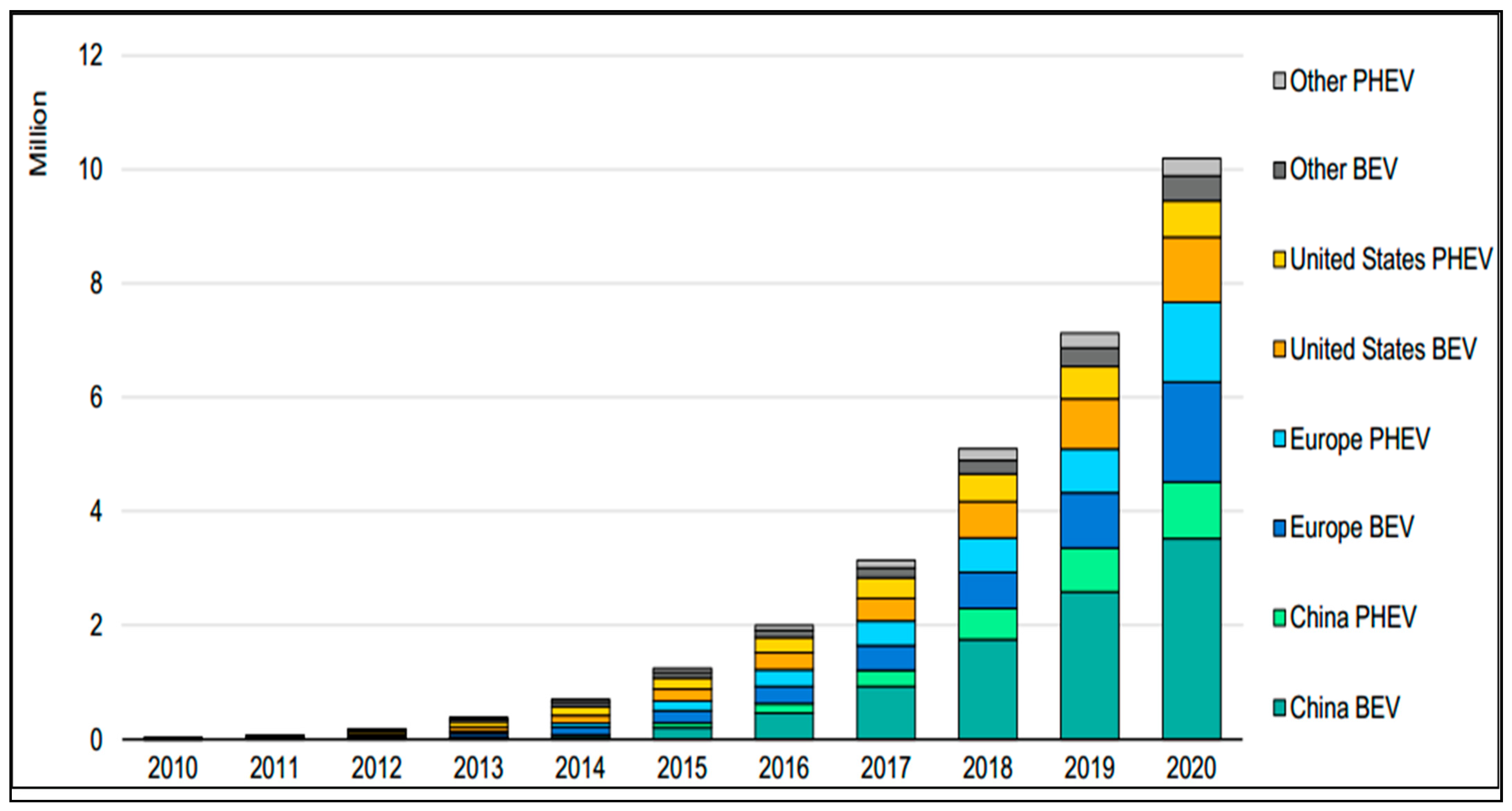


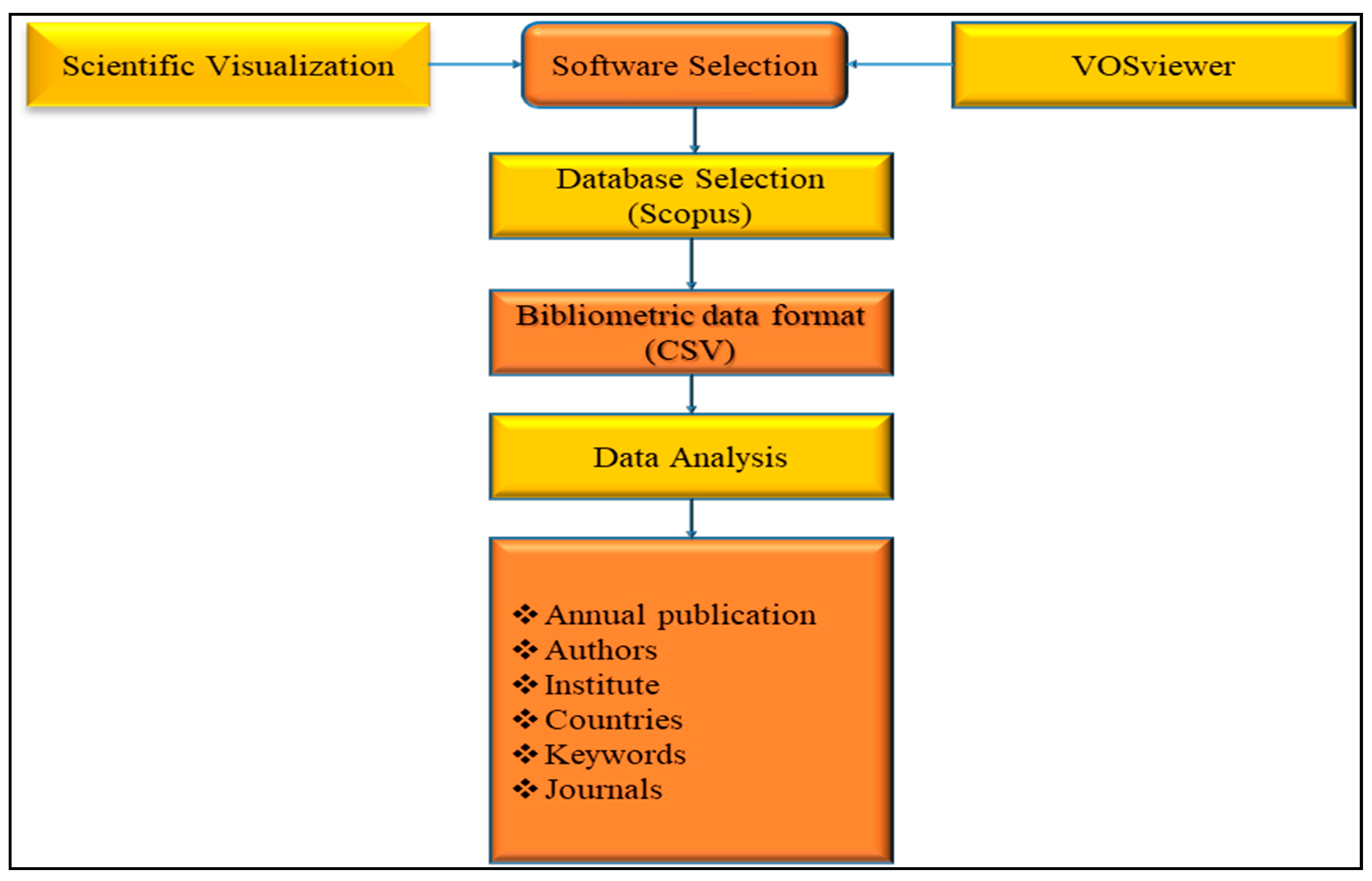
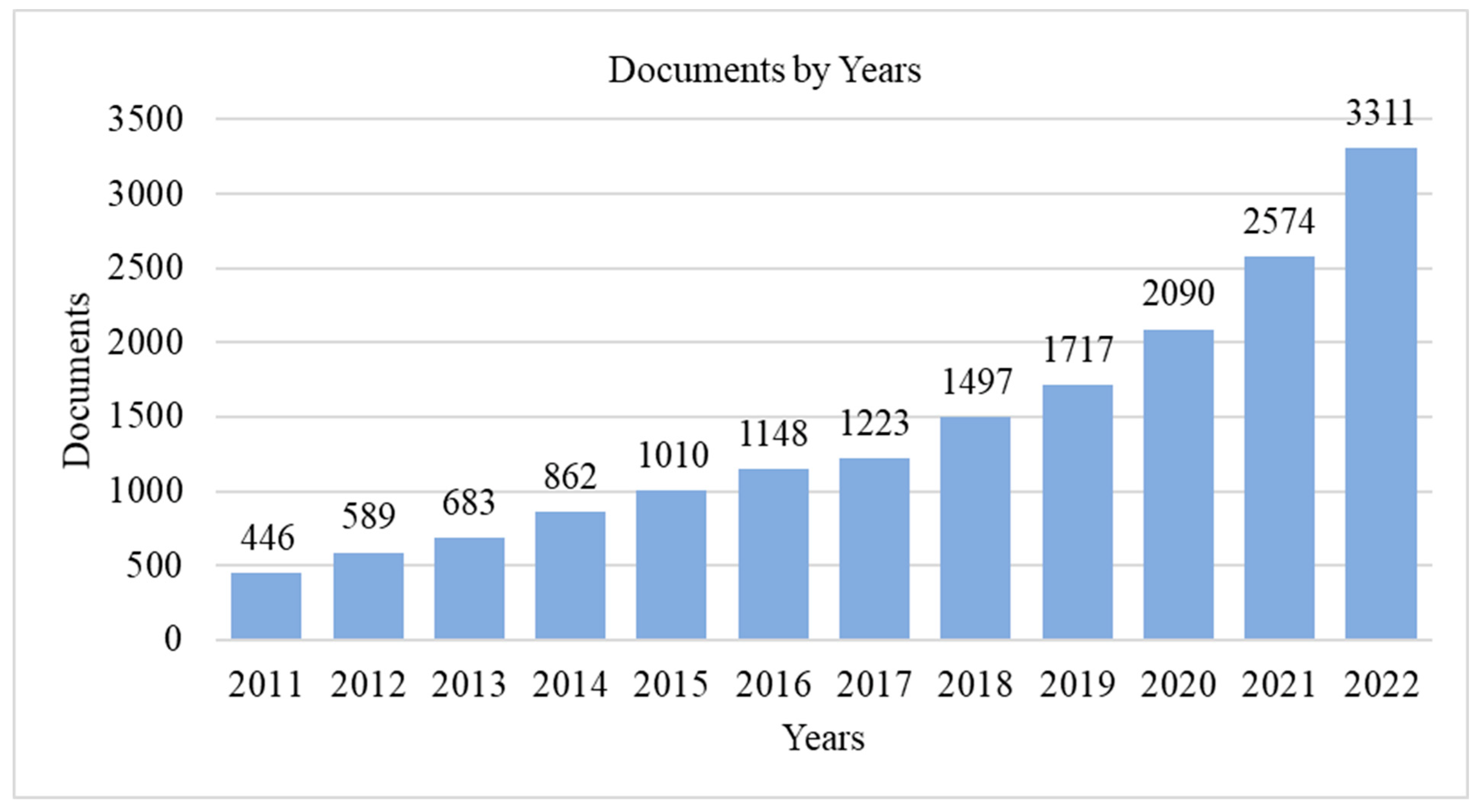

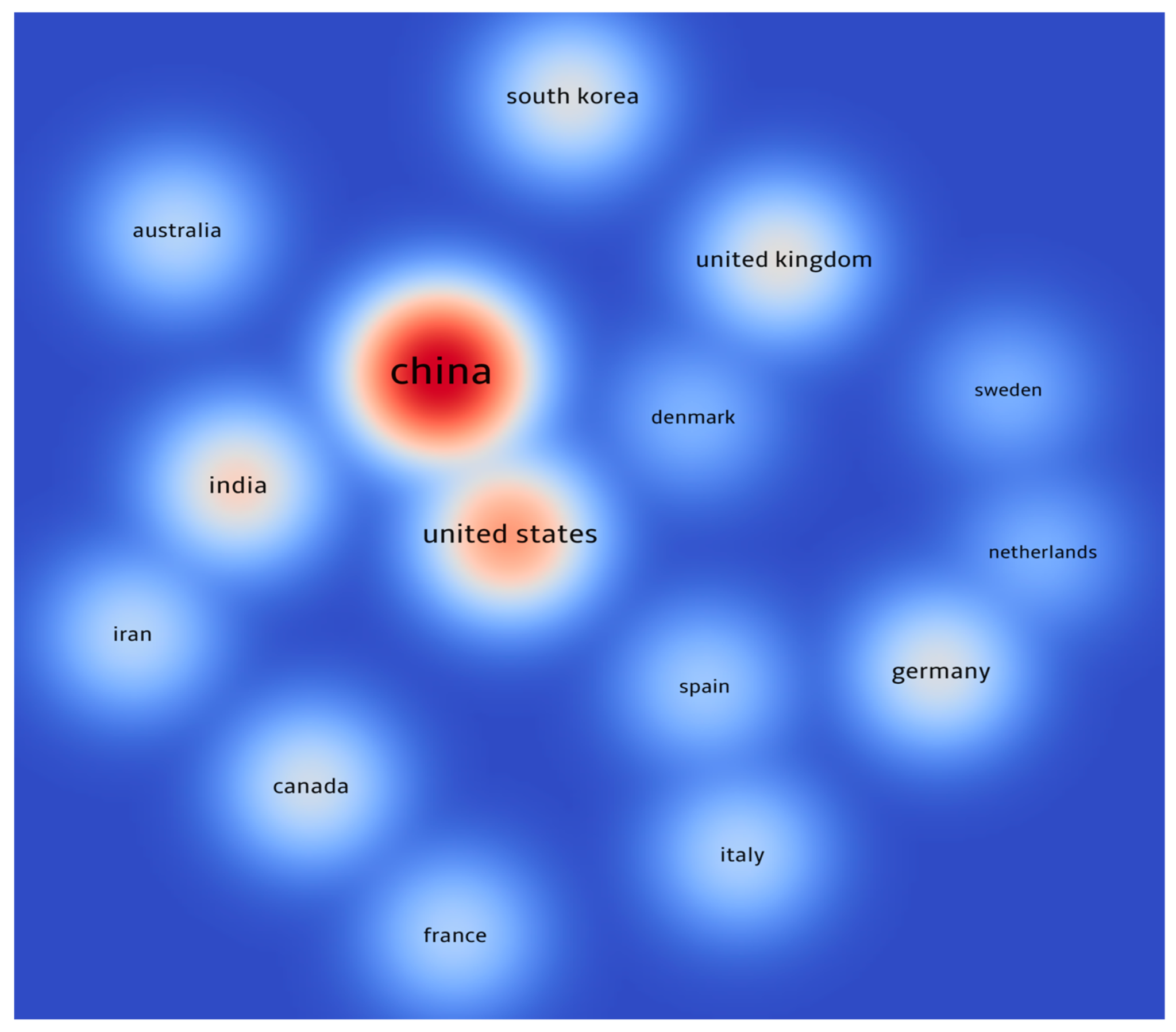

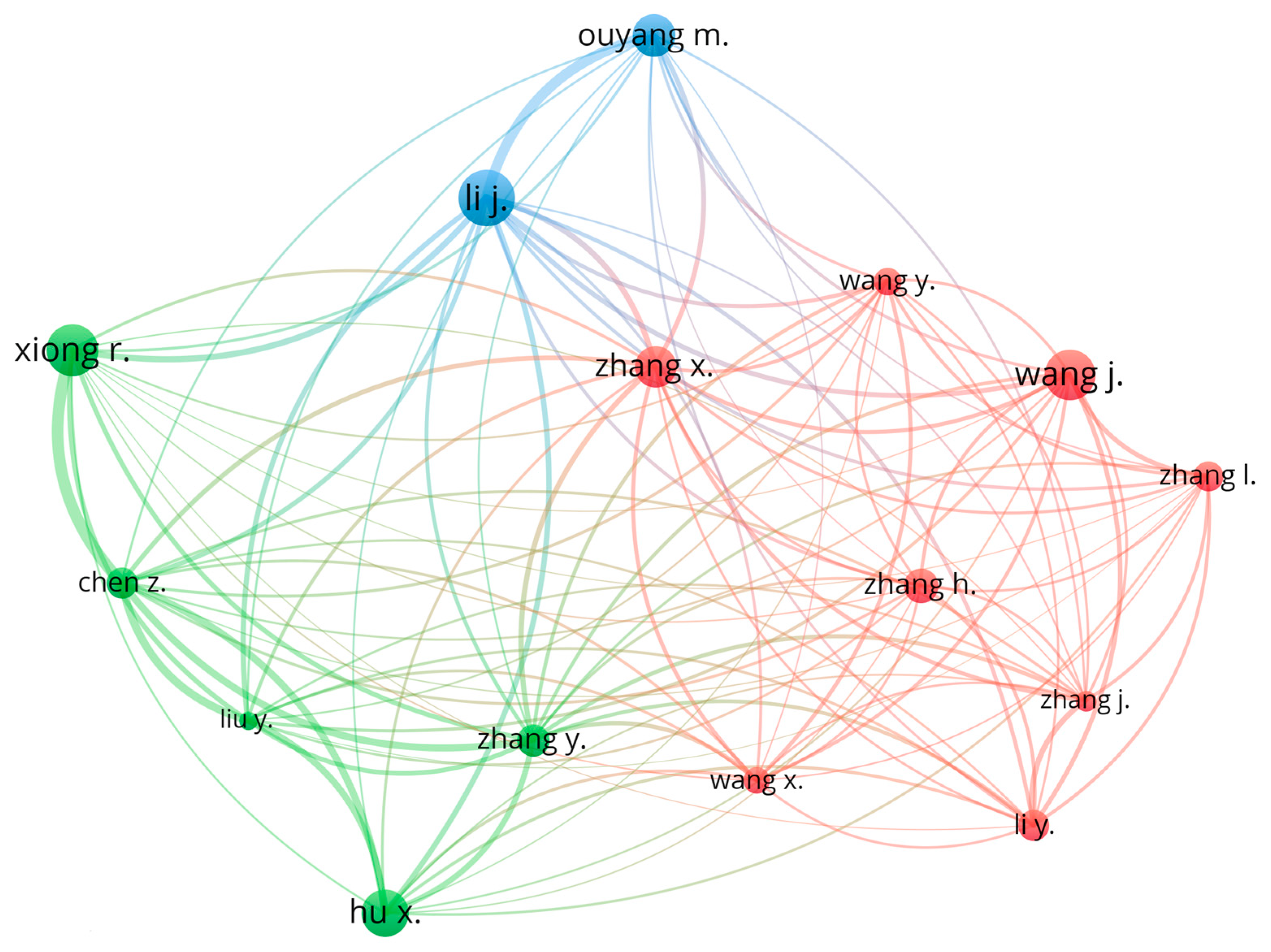
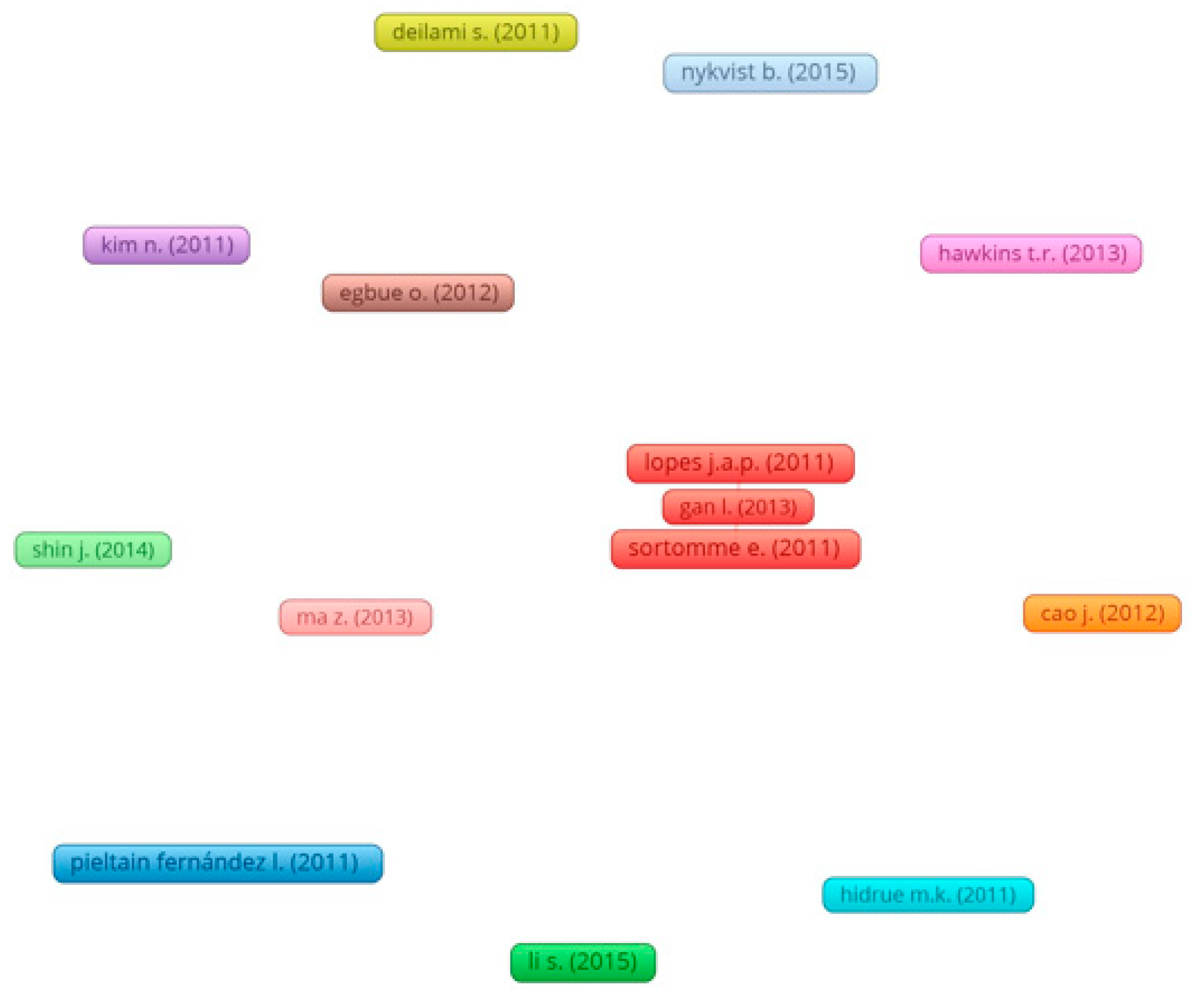
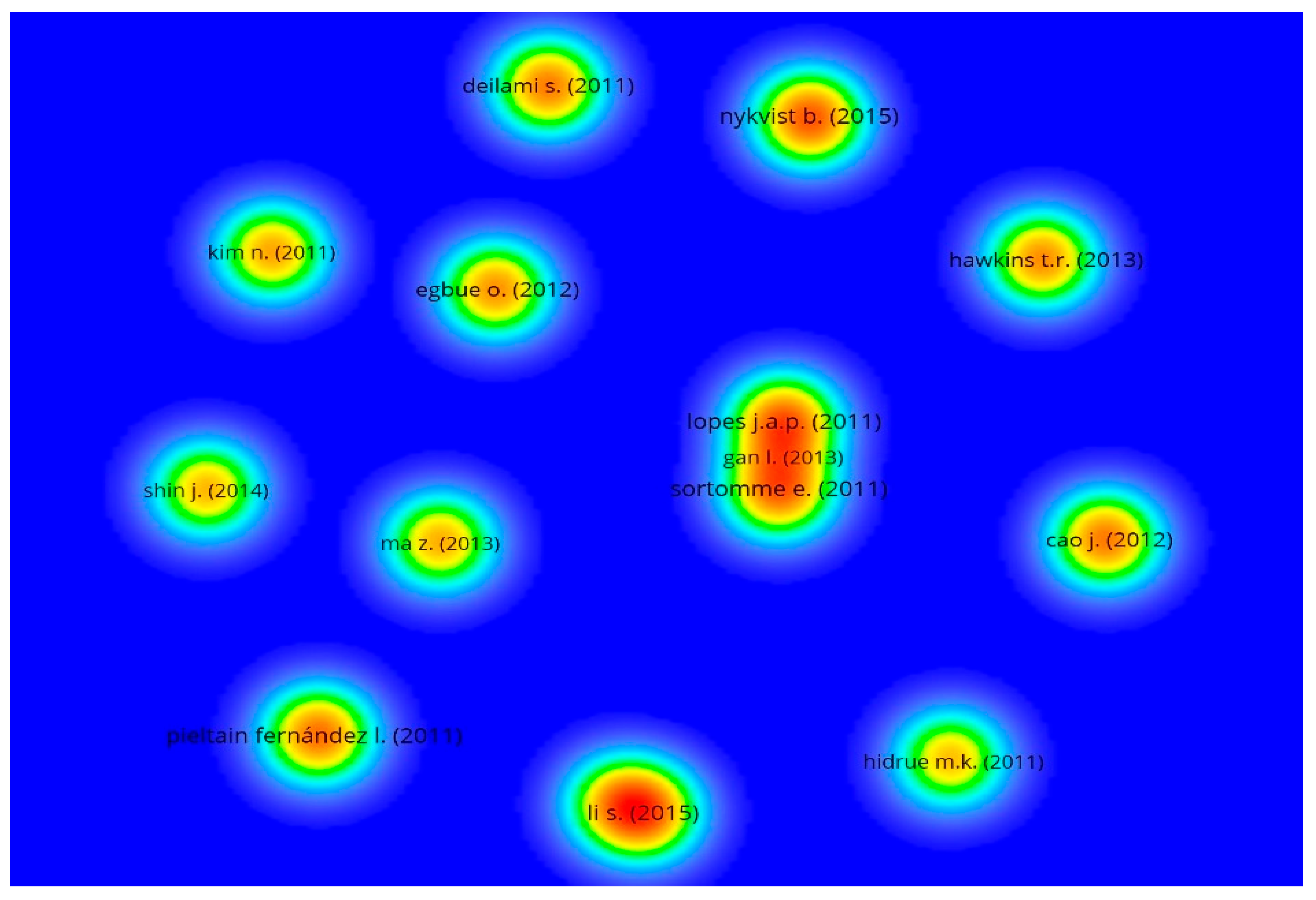
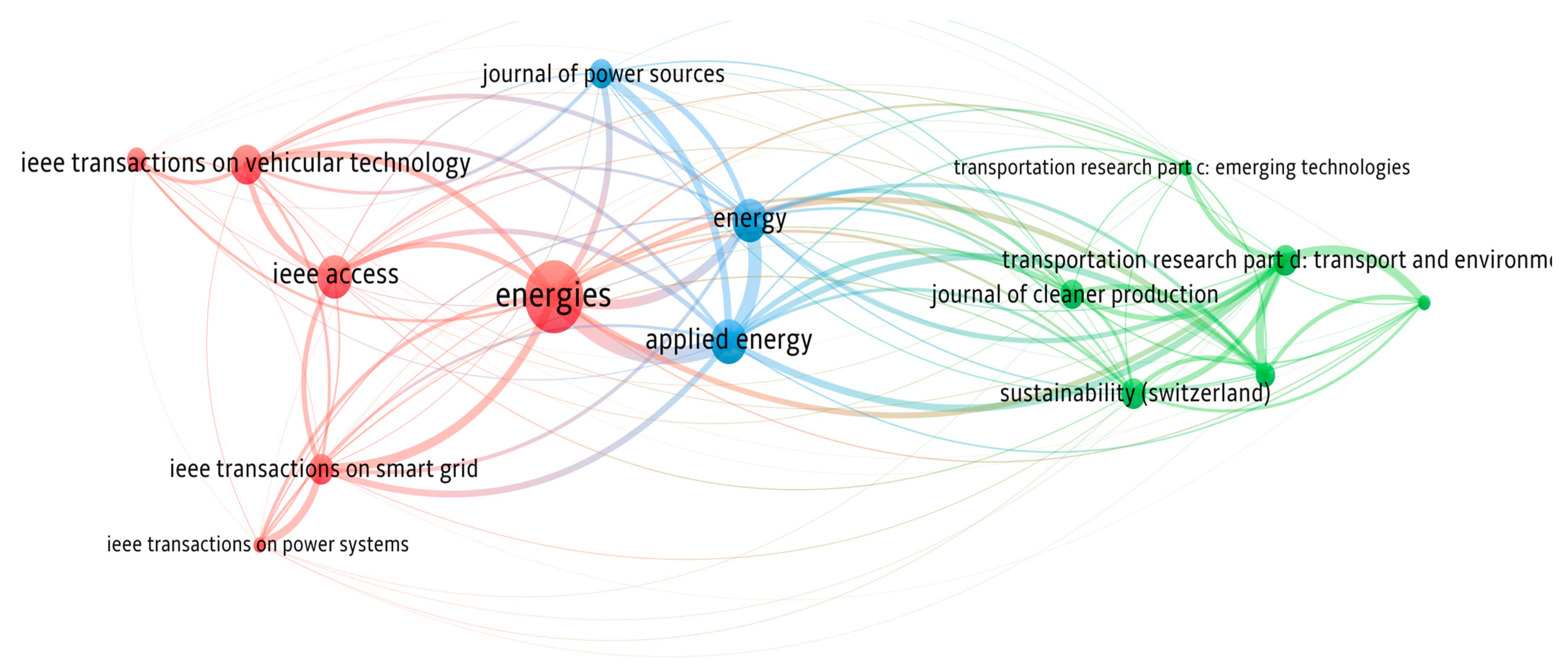
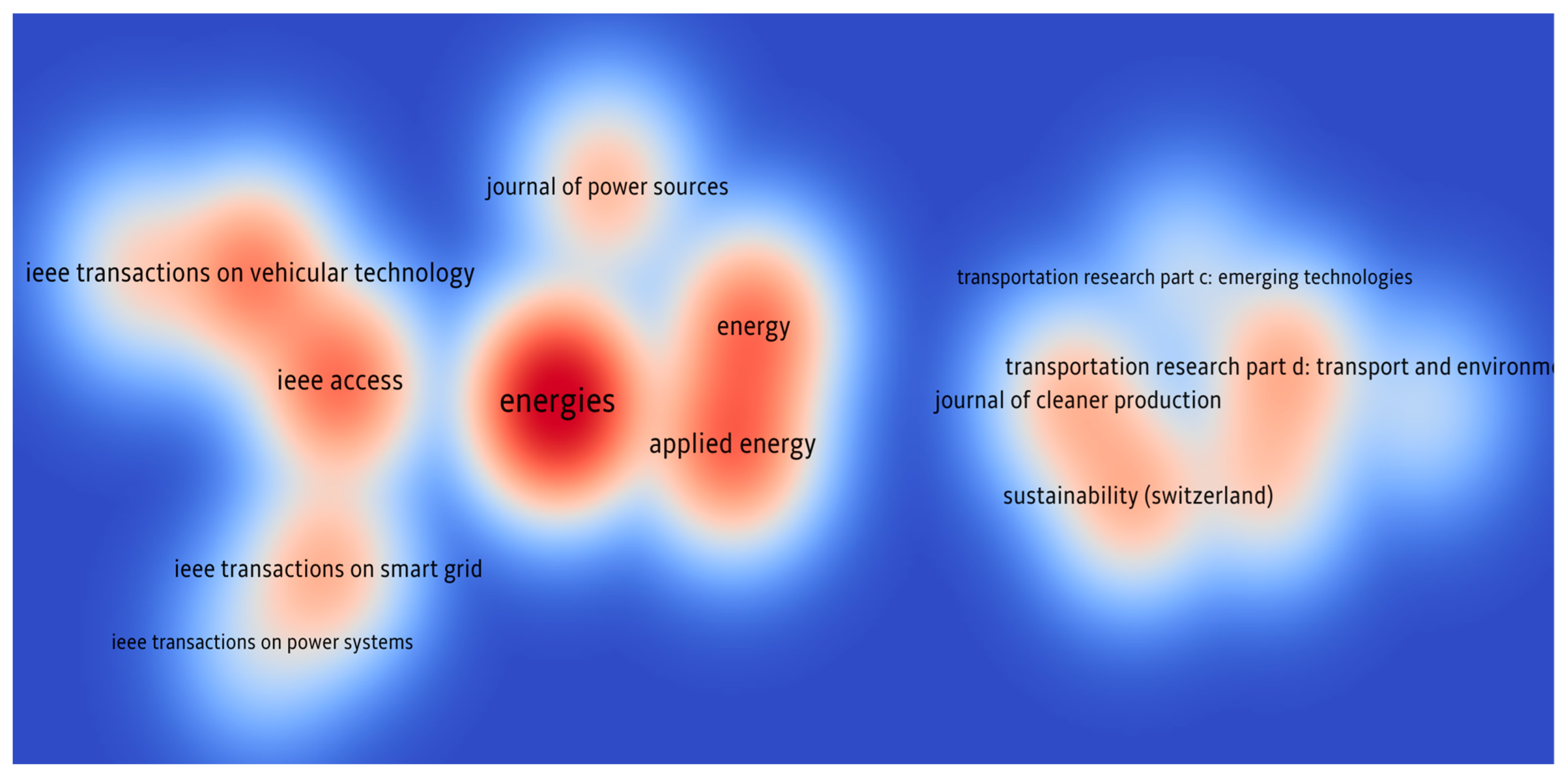

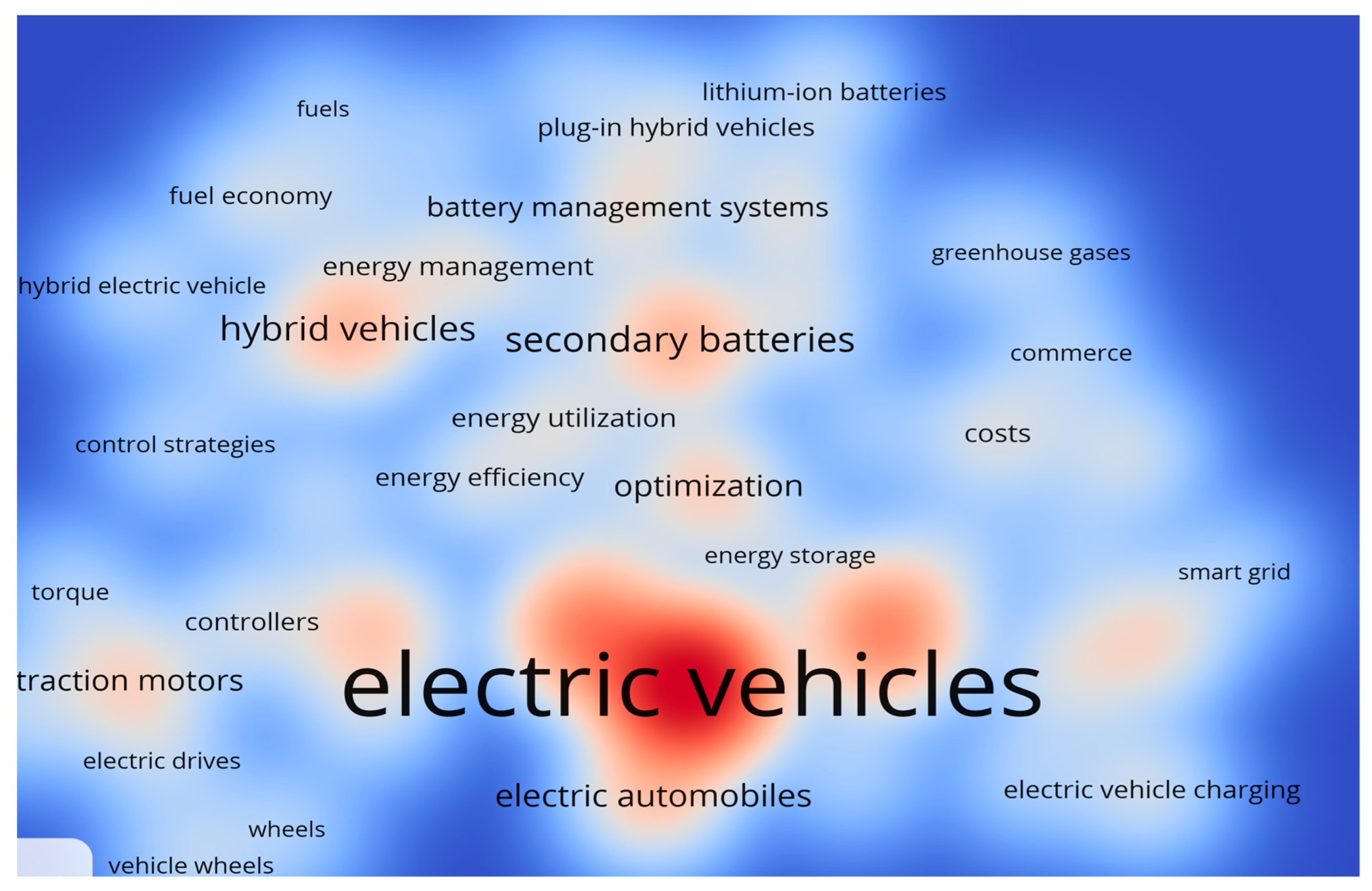

| Country | Documents | Citations | Country Contributions | Total Link Strength |
|---|---|---|---|---|
| China | 5933 | 70,685 | 42.72% | 26,725 |
| United States | 1891 | 59,679 | 13.62% | 22,148 |
| India | 985 | 4171 | 7.09% | 5390 |
| United kingdom | 769 | 16,366 | 5.54% | 9455 |
| South Korea | 695 | 11,822 | 5.00% | 4507 |
| Germany | 673 | 11,932 | 4.85% | 5732 |
| Canada | 597 | 14,510 | 4.30% | 6636 |
| Iran | 438 | 7291 | 3.15% | 4134 |
| Australia | 432 | 10,032 | 3.11% | 5333 |
| Iltaly | 387 | 7430 | 2.79% | 3474 |
| France | 379 | 6624 | 2.73% | 2698 |
| Spain | 188 | 4177 | 1.35% | 2790 |
| Denmark | 186 | 4244 | 1.34% | 2632 |
| Sweden | 170 | 5066 | 1.22% | 2583 |
| Netherlands | 166 | 5005 | 1.20% | 2561 |
| Organization | Documents | Citations | Organization Contribution | Total Link Strength |
|---|---|---|---|---|
| State Key Laboratory of Automotive Safety and Energy, Tsinghua University, Beijing, 100084, China | 121 | 2421 | 16.95% | 169 |
| School Of Mechanical Engineering, Beijing Institute of Technology, Beijing, 100081, China | 89 | 620 | 12.46% | 127 |
| School of Automotive Studies, Tongji University, Shanghai, 201804, China | 73 | 417 | 10.22% | 39 |
| National Engineering Laboratory for Electric Vehicles, Beijing Institute of Technology, Beijing, 100081, China | 64 | 1329 | 8.96% | 143 |
| State Key Laboratory of Automotive Simulation and Control, Jilin University, Changchun, 130022, China | 59 | 337 | 8.26% | 37 |
| School of Electrical Engineering, Southeast University, Nanjing, 210096, China | 53 | 519 | 7.42% | 9 |
| School of Automotive and Traffic Engineering, Jiangsu University, Zhenjiang, 212013, China | 43 | 301 | 6.02% | 81 |
| National Engineering Laboratory for Electric Vehicles, School of Mechanical Engineering, Beijing Institute of Technology, Beijing, 100081, China | 38 | 1327 | 5.32% | 102 |
| Collaborative Innovation Center of Electric Vehicles in Beijing, Beijing Institute of Technology, Beijing, 100081, China | 37 | 1109 | 5.18% | 123 |
| Automotive Engineering Research Institute, Jiangsu University, Zhenjiang, 212013, China | 36 | 318 | 5.04% | 92 |
| College of Electrical Engineering, Zhejiang University, Hangzhou, 310027, China | 35 | 792 | 4.90% | 6 |
| State Key Laboratory of Automotive Safety and Energy, Tsinghua University, Beijing 100084, China | 27 | 1119 | 3.78% | 78 |
| Faculty of Transportation Engineering, Kunming University of Science and Technology, Kunming, 650500, China | 24 | 203 | 3.36% | 104 |
| State Key Laboratory Of Mechanical Transmissions, Department of Automotive Engineering, Chongqing University, Chongqing, 400044, China | 8 | 395 | 1.12% | 40 |
| Advanced Vehicle Engineering Centre, Cranfield University, Cranfield, United Kingdom | 7 | 572 | 0.98% | 62 |
| Author | Documents | Citations | Average Citations | Total Link Strength |
|---|---|---|---|---|
| Li Y. | 241 | 2359 | 10 | 449 |
| Wang Y. | 240 | 2106 | 9 | 412 |
| Zhang Y. | 240 | 2458 | 10 | 595 |
| Zhang X. | 224 | 3245 | 14 | 546 |
| Wang J. | 223 | 3972 | 18 | 473 |
| Li J. | 214 | 4491 | 21 | 676 |
| Liu Y. | 194 | 1332 | 7 | 528 |
| Wang X. | 174 | 2052 | 12 | 404 |
| Zhang J. | 165 | 1596 | 10 | 415 |
| Zhang L. | 157 | 2309 | 15 | 363 |
| Zhang H. | 141 | 2626 | 19 | 367 |
| Chen Z. | 124 | 2425 | 20 | 648 |
| Ouyang M. | 70 | 3323 | 47 | 428 |
| Hu X. | 65 | 3694 | 57 | 483 |
| Xiong R. | 59 | 4112 | 70 | 467 |
| Document | Citations | Links | References |
|---|---|---|---|
| Nykvist, B.; Nilsson, M. (2015), Rapidly falling costs of battery packs for electric vehicles. Nature climate change, | 933 | 0 | [72] |
| Li, S.; Mi, C.C. (2015), Wireless Power Transfer for Electric Vehicle Applications | 930 | 1 | [73] |
| Lopes, J.A.P.; Soares, F.J.; Almeida, P.M.R. (2011), Integration of Electric Vehicles in the Electric Power System | 894 | 1 | [74] |
| Sortomme, E.; El-Sharkawi, M.A. (2011), Coordinated Charging of Plug-In Hybrid Electric Vehicles to Minimize Distribution System Losses | 818 | 1 | [75] |
| Fernandez, L.P.; San Román, T.G.; Cossent, R.; Domingo, C.M.; Frias, P. (2011), Assessment of the Impact of Plug-in Electric Vehicles on Distribution Networks | 801 | 0 | [76] |
| Cao, J.; Emadi, A. (2012), A New Battery/UltraCapacitor Hybrid Energy Storage System for Electric, Hybrid, and Plug-In Hybrid Electric Vehicles | 752 | 0 | [77] |
| Deilami, S.; Masoum, A.S.; Moses, P.S.; Masoum, M.A. (2011), Real-Time Coordination of Plug-In Electric Vehicle Charging in Smart Grids to Minimize Power Losses and Improve Voltage Profile | 739 | 0 | [78] |
| Hawkins, T.R.; Singh, B.; Majeau-Bettez, G.; Strømman, A.H. (2013), Comparative Environmental Life Cycle Assessment of Conventional and Electric Vehicles | 673 | 0 | [30] |
| Egbue, O.; Long, S. (2012), Barriers to widespread adoption of electric vehicles: An analysis of consumer attitudes and perceptions | 651 | 0 | [79] |
| Budhia, M.; Boys, J.T.; Covic, G.A.; Huang, C.-Y. (2013), Development of a Single-Sided Flux Magnetic Coupler for Electric Vehicle IPT Charging Systems | 614 | 1 | [80] |
| Kim, N.; Cha, S.; Peng, H. (2011), Optimal Control of Hybrid Electric Vehicles Based on Pontryagin’s Minimum Principle | 579 | 0 | [81] |
| Gan, L.; Topcu, U.; Low, S.H. (2013), Optimal decentralized protocol for electric vehicle charging | 563 | 2 | [82] |
| Ma, Z.; Callaway, D.S.; Hiskens, I.A. (2013), Decentralized Charging Control of Large Populations of Plug-in Electric Vehicles | 544 | 0 | [83] |
| Shin, J.; Shin, S.; Kim, Y.; Ahn, S.; Lee, S.; Jung, G.; Jeon, S. -J.; Cho, D.-H. (2014), Design and Implementation of Shaped Magnetic-Resonance-Based Wireless Power Transfer System for Roadway-Powered Moving Electric Vehicles | 514 | 0 | [84] |
| Hidrue m.k. (2011), Willingness to pay for electric vehicles and their attributes | 489 | 0 | [85] |
| Source | Documents | Citations | Document Contributions | Citation Contributions | Total Link Strength |
|---|---|---|---|---|---|
| Energies | 925 | 7533 | 22.62% | 7.01% | 2794 |
| Applied Energy | 423 | 14,831 | 10.34% | 13.81% | 2967 |
| IEEE Access | 404 | 2417 | 9.88% | 2.25% | 1241 |
| Energy | 391 | 8960 | 9.56% | 8.34% | 2197 |
| IEEE Transactions on Vehicular Technology | 349 | 11,055 | 8.53% | 10.29% | 1249 |
| Transportation Research Part D: Transport And Environment | 226 | 5864 | 5.53% | 5.46% | 1985 |
| IEEE Transactions on Smart Grid | 222 | 13,348 | 5.43% | 12.43% | 1486 |
| Sustainability (Switzerland) | 221 | 1216 | 5.40% | 1.13% | 1107 |
| Journal of Cleaner Production | 208 | 3620 | 5.09% | 3.37% | 1195 |
| Journal of Power Sources | 204 | 11,239 | 4.99% | 10.46% | 1197 |
| Energy Policy | 155 | 7284 | 3.79% | 6.78% | 1558 |
| IEEE Transactions on Industrial Electronics | 149 | 7860 | 3.64% | 7.32% | 418 |
| IEEE Transactions on Power Systems | 73 | 6798 | 1.78% | 6.33% | 765 |
| Transportation Research Part C: Emerging Technologies | 71 | 2774 | 1.74% | 2.58% | 680 |
| Transportation Research Part A: Policy And Practice | 69 | 2618 | 1.69% | 2.44% | 883 |
| Keyword | Occurrences | % Age | Total Link Strength | Keyword | Occurrences | % Age | Total Link Strength |
|---|---|---|---|---|---|---|---|
| Electric vehicles | 6615 | 18.52% | 20,947 | Lithium-ion batteries | 539 | 1.51% | 2204 |
| Energy storage | 2494 | 6.98% | 11,069 | Matlab | 462 | 1.29% | 2197 |
| Secondary batteries | 1562 | 4.37% | 7624 | Vehicle wheels | 450 | 1.26% | 2000 |
| Hybrid vehicles | 1500 | 4.20% | 5836 | Hybrid electric vehicle | 441 | 1.23% | 1521 |
| Energy management | 779 | 2.18% | 3706 | Vehicle performance | 441 | 1.23% | 1953 |
| Electric automobiles | 1266 | 3.54% | 4893 | Permanent magnets | 440 | 1.23% | 1442 |
| Electric machine control | 1196 | 3.35% | 5811 | Energy storage | 434 | 1.22% | 2028 |
| Optimization | 1088 | 3.05% | 5019 | Charging station | 400 | 1.12% | 1666 |
| Traction motors | 983 | 2.75% | 4140 | Control strategies | 400 | 1.12% | 1793 |
| Electric power transmission networks | 885 | 2.48% | 4598 | Commerce | 399 | 1.12% | 1645 |
| Battery management systems | 815 | 2.28% | 4127 | Electric drives | 398 | 1.11% | 1664 |
| Energy utilization | 731 | 2.05% | 3233 | Torque | 387 | 1.08% | 1752 |
| Costs | 699 | 1.96% | 3263 | Scheduling | 382 | 1.07% | 1753 |
| Electric batteries | 699 | 1.96% | 4094 | Wheels | 377 | 1.06% | 1636 |
| Vehicle-to-grid | 648 | 1.81% | 3175 | Stochastic systems | 375 | 1.05% | 1710 |
| Electric vehicle charging | 630 | 1.76% | 2779 | Dc-dc converters | 368 | 1.03% | 1406 |
| Energy efficiency | 624 | 1.75% | 2875 | Electric power distribution | 368 | 1.03% | 1726 |
| Battery electric vehicles | 618 | 1.73% | 2695 | Plug in hybrid electric vehicles | 368 | 1.03% | 2059 |
| Controllers | 609 | 1.70% | 2592 | Automotive batteries | 358 | 1.00% | 1367 |
| Plug-in electric vehicles | 599 | 1.68% | 2322 | Vehicle transmissions | 353 | 0.99% | 1413 |
| Plug-in hybrid vehicles | 590 | 1.65% | 3052 | Genetic algorithms | 346 | 0.97% | 1614 |
| Fuel economy | 581 | 1.63% | 2609 | Smart grid | 345 | 0.97% | 1622 |
| Energy management strategies | 338 | 0.95% | 1857 | Greenhouse gases | 339 | 0.95% | 1454 |
Disclaimer/Publisher’s Note: The statements, opinions and data contained in all publications are solely those of the individual author(s) and contributor(s) and not of MDPI and/or the editor(s). MDPI and/or the editor(s) disclaim responsibility for any injury to people or property resulting from any ideas, methods, instructions or products referred to in the content. |
© 2023 by the authors. Licensee MDPI, Basel, Switzerland. This article is an open access article distributed under the terms and conditions of the Creative Commons Attribution (CC BY) license (https://creativecommons.org/licenses/by/4.0/).
Share and Cite
Ullah, I.; Safdar, M.; Zheng, J.; Severino, A.; Jamal, A. Employing Bibliometric Analysis to Identify the Current State of the Art and Future Prospects of Electric Vehicles. Energies 2023, 16, 2344. https://doi.org/10.3390/en16052344
Ullah I, Safdar M, Zheng J, Severino A, Jamal A. Employing Bibliometric Analysis to Identify the Current State of the Art and Future Prospects of Electric Vehicles. Energies. 2023; 16(5):2344. https://doi.org/10.3390/en16052344
Chicago/Turabian StyleUllah, Irfan, Muhammad Safdar, Jianfeng Zheng, Alessandro Severino, and Arshad Jamal. 2023. "Employing Bibliometric Analysis to Identify the Current State of the Art and Future Prospects of Electric Vehicles" Energies 16, no. 5: 2344. https://doi.org/10.3390/en16052344
APA StyleUllah, I., Safdar, M., Zheng, J., Severino, A., & Jamal, A. (2023). Employing Bibliometric Analysis to Identify the Current State of the Art and Future Prospects of Electric Vehicles. Energies, 16(5), 2344. https://doi.org/10.3390/en16052344










